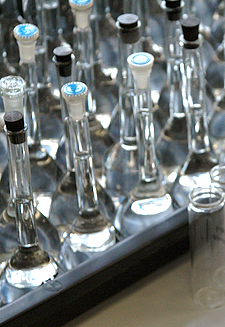Mohamed Abdelsalam

M.Sc. Mohamed Abdelsalam
Dr. Mohamed Abdelsalam
Tel ++49 345 55 25188
e-mail: mohamed.abdelsalam(at)pharmazie.uni-halle.de
Entwicklung neuer chemischer Sonden zur Analyse der Funktionen von HDACs der Klassen I und IIb in FLT3-ITD-positiven leukämischen Zellen
Mutationen in der FMS-verwandten Tyrosinkinase (FLT3) verursachen eine AML mit schlechter Patientenprognose. Epigenetische Modifikatoren der Histondeacetylase (HDAC)-Familie kontrollieren die Entwicklung und das Überleben normaler und transformierter Blutzellen. Inhibitoren der zinkabhängigen HDACs (HDACi) sind zugelassene Medikamente gegen Subtypen von Leukämie und Lymphomen. Es gibt 11 zinkabhängige HDACs in Säugetierzellen, und es wird weiterhin intensiv daran geforscht, ihre genauen Funktionen zu sezieren. Im vorliegenden Projekt werden wir neue, hochspezifische Inhibitoren von HDACs und FLT3 entwickeln, um ihre Rolle in Krebszellen zu analysieren.
Ein weiterer Ansatzpunkt ist die Entwicklung von Protein-abbauenden Wirkstoffen, den sogenannten PROTACs, für die untersuchten HDACs und FLT3-ITD. PROTACs sollen gezielt die Targeproteine in den untersuchten Krebsszellen abbauen um dort die biologische Rolle beser zu verstehen lernen.
Kooperation: Prof. Dr. Oliver Krämer, Institut für Toxikologie, Universität Mainz
Publications
M. Abdelsalam, M. Zmyslia, K. Schmidtkunz, A. Vecchio, M. Zessin, M. Schutkowski, M. Jung, C. Jessen-Trefzer, W. Sippl. Design and synthesis of bioreductive prodrugs of class I histone deacetylase inhibitors and their biological evaluation in virally transfected acute myeloid leukemia cells. Arch Pharm (Weinheim). e2300536, 2023. doi:10.1002/ardp.202300536 .
M. Abdelsalam, H. S. Ibrahim, L. Krauss, M. Zessin, A. Vecchio, S. Hastreiter, M. Schutkowski, G. Schneider, W. Sippl. Development of pyrazine-anilinobenzamides as histone deacetylase HDAC1-3 selective inhibitors and biological testing against pancreas cancer cell lines. Methods Mol Biol. 2589:145-155, 2023. doi:10.1007/978-1-0716-2788-4_10
M. Abdelsalam, M. Zessin, M. Schmidt, M. Schutkowski and W. Sippl. N1-(2-Amino-4-fluorophenyl)-N4-(3-(2-(2-(3-((2-(2,6-dioxopiperidin-3-yl)-1,3-dioxoisoindolin-4yl)amino)propoxy)ethoxy)ethoxy)propyl)terephthalamide. Molbank 2022, 2022(4), M1501; https://doi.org/10.3390/M1501
E. F. Bülbül, J. Melesina, H. S. Ibrahim, M. Abdelsalam, A. Vecchio, D. Robaa, M. Zessin, M. Schutkowski, and W. Sippl.
Docking, Binding Free Energy Calculations and in vitro Characterization of Pyrazine Linked 2-Aminobenzamides as new Class I Histone Deacetylase (HDAC) Inhibitors.
Molecules. 2022 Apr 14;27(8):2526. doi:10.3390/molecules27082526 .
E. Ghazy, M. Abdelsalam, D. Robaa, R.J. Pierce, W. Sippl.
Histone deacetylase (HDAC) inhibitors for the treatment of Schistosomiasis.
Pharmaceuticals 15(1), 80, 2022. https://doi.org/10.3390/ph15010080
H. Ibrahim, M. Abdelsalam, Y. Zeyn, M. Zessin, E F. Bülbül, A. M. Mustafa, M. A. Fischer, P. Zeyen, A. Vecchio, P. Sun, F. Erdmann, M. Schmidt, D. Robaa, C. Romier, M. Schutkowski, O. H. Krämer, and W. Sippl.
Synthesis and structure-activity relationship studies of pyrazine linked 2-aminobenzamides as new class I selective histone deacetylase (HDAC) inhibitors and their biological characterization in leukemic cellsInt.
J. Mol. Sci. 23(1), 369, 2022. https://doi.org/10.3390/ijms23010369
Full publication list





